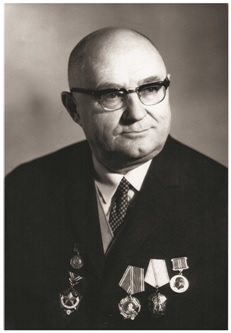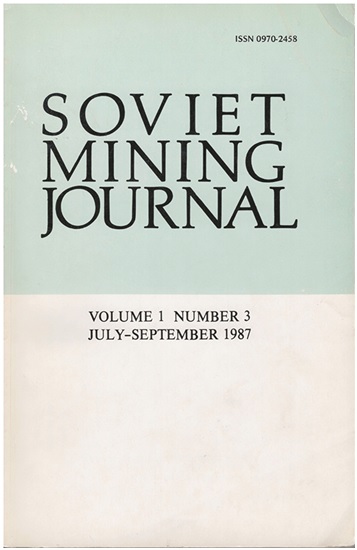The News of the Higher Institutions Series. The foundation of a highly reputed Soviet academic journal series, News of the Higher Institutions (Izvestiya vysshikh uchebnykh zavedenii or Izvestiia vuzov for short), was laid at a top-level meeting of higher education institutions controlled by the Ministry of Higher and Secondary Specialized Education of the USSR. The meeting took place in Moscow on 18–21 February 1957. It was a period of changes in the country. A year earlier, in February 1956, the well-known 20th Party Congress took place, where Nikita Khrushchev, the First Secretary of the Soviet Union Communist Party (CPSU) Central Committee, made a report on Stalin’s cult of personality. This historical period, usually called the “Khrushchev thaw”, was marked by massive changes in various areas, including higher education, and resulted in modern internationally oriented academic journals development. The meeting was a milestone that established another scientific series on 13 branches of knowledge, Scientific Essays of Higher Education.
News of the Higher Institutions initially emerged as a series of interacademic publications in various fields of science and technology (about 20 originally), and it only expanded afterward. Specialized higher education institutions throughout the country were charged with publishing scientific journals. So since 1957–1958, scientific journals of the series have been coming out on a regular basis.
|
|
News of the Higher Institutions. Mining Journal. So, the top-level meeting of 1957 established two series of scientific publications, namely News of the Higher Institutions and Scientific Essays of Higher Education. Two leading educational institutions were in charge of publishing journals on mining sciences. Moscow Mining Institute (now part of the National University of Science and Technology MISiS) published Scientific Essays of Higher Education. Mining Sciences, while Sverdlovsk Mining Institute (now Ural State Mining University UrSMU) was in charge of News of the Higher Institutions. Mining Journal. The first issue of the latter came out in January 1958. However, as early as 1959, both publications merged under the binder of News of the Higher Institutions. Mining Journal with an editorial office in Sverdlovsk (now Ekaterinburg) therefore creating a major periodical of mining and mining-metallurgical universities, as well as mining faculties of polytechnic institutes throughout the country. |
The editorial staff and editorial board. Editors-in-chief:
1958 (January to March) Sergei A. Fedorov;
1958–1959 Sergei A. Volotkovskii;
1959–2000 Abram E. Trop;
2001–2009 Ivan V. Dementiev;
2009–2018 Mikhail V. Kornilkov;
2018–2021 Evgenii F. Tsypin;
Since 2021 Niiaz G. Valiev.
|
|
The first issue of News of the Higher Institutions. Mining Journal was established by the decree of the Ministry of Higher and Secondary Specialized Education of the USSR no. I-86 of 20 August 1957. The first issue pointed out that the publication of such journal “will open up plenty of opportunities for the higher mining education teaching personnel to publish scientific papers”. The first issue came out due to the Doctor of Engineering sciences, Professor, a prominent scientist in underground construction, Sergei A. Fedorov, who developed the structure of the journal, recruited the first editorial board, and formed the technical editing staff. S. A. Fedorov balanced his work as editor-in-chief, vice-rector of the Sverdlovsk Mining Institute, and Head of the Mine Construction Department. He resigned as editor-in-chief upon the publication of the first issue and focused on other duties. |
|
|
Professor Sergei A. Volotkovskii, Doctor of Engineering sciences and a specialist in mine electric transport, edited the second issue of the journal. |
|
|
|
A. Volotkovskii was offered to chair the Department of Mining Operations and Enterprises Electrification in 1959, and Abram E. Trop took over as editor-in-chief. He held this position for more than forty years between 1959 and 2000. Doctor of Engineering sciences, Professor, Head of the Department of Computer-Aided Manufacturing of the Sverdlovsk Mining Institute, A. E. Trop was a specialist in the workflow and production control in the mining sector (his main scientific field was the statics and dynamics of workflows in mining and processing, mechanisms, and machines as automation objects). Under his guidance, the journal rose, developed, and attracted prominent scientists from various fields of mining sciences to publish their works on the pages of News of the Higher Institutions. Mining Journal. At that time, the journal has earned its high academic reputation. |
|
|
|
Professor Ivan V. Dementiev headed the journal after the death of A. E. Trop. I. V. Dementiev was a rector of Sverdlovsk Mining Institute from 1988 to 2000. Back at the time, the institute changed its name for the Ural State Mining and Geological Academy, and I. V. Dementiev became the first rector elected by the staff but not appointed from the top-down. After stepping down as rector, he acted as editor-in-chief of the journal from 2001 to 2009. As a specialist in new technologies development for copper-pyrite and polymetallic deposits underground mining, I. V. Dementiev paid great attention to the journal remit development and science-practice connection strengthening. |
|
|
|
Professor Mikhail V. Kornilkov, Doctor of Engineering sciences, was the successor of I. V. Dementiev and held the position of editor-in-chief in 2009-2018. The Head of the Mine Construction Department, a well-known specialist in blasting technology and safety, mine support, the development of metropolitan areas (including the underground space of Ekaterinburg, where his developments formed the basis of a section of the City Master Plan), M. V. Kornilkov was a perfect administrator and a talented teacher. |
|
|
|
From 2018 to 2021, the journal was headed by Evgenii F. Tsypin, Doctor of Engineering sciences, Professor, professor of UrSMU Mineral Processing Department, a specialist in the theory and technology of mineral and technogenic raw material preconcentration and the study of minerals washability. |
|
|
|
Since 2021, News of the Higher Institutions. Mining Journal has been edited by Niiaz G. Valiev, Doctor of Engineering sciences, Professor, vice-rector for research, first vice-rector (in 2008–2019), Head of Department of Mining (since 2009), a specialist in placer mining, full member of the International Academy of Ecology and Life Protection Sciences, and Academy of Mining Sciences. |
Talented scientists and distinguished specialists in their fields have worked as deputy editor-in-chief of the journal: Petr V. Vaganov, Vitalii G. Simanov, Lev A. Sorokin, Oleg G. Latyshev. Currently, this position is held by Iurii I. Lel, Doctor of Engineering sciences, Professor, Head of UrSMU Department of Opencast Mining, a specialist in mining technology and quarry transport.
Eminent scientists from Sverdlovsk, Moscow, and Dnepropetrovsk Mining Institutes as well as Kuzbass Polytechnic Institute joined the first editorial board of the journal, namely Associate Professor V. M. Arashkevich, Professor S. A. Volotkovskii, Associate Professor G. I. Vilesov, Associate Professor P. V. Vaganov, Professor A. I. Veselov, Associate Professor L. I. Zhukov, Professor P. I. Kokorin, Professor V. S. Muchnik, Professor A. I. Nedoluzhenko, Professor V. V. Ogievsky, Associate Professor Iu. S. Petrov, Professor N. S. Poliakov, Professor E. F. Ratnikov, Professor D. V. Topchiev, and Associate Professor V. S. Khokhriakov.
The modern editorial board of the journal is represented by distinguished Russian scientists from Moscow, St. Petersburg, Krasnoyarsk, Irkutsk, Kemerovo, Krasnodar, Ekaterinburg, Perm, and foreign colleagues from Germany, Bulgaria, Poland, Mongolia, Ukraine, and Kazakhstan.
Remit and uniqueness of the journal. As early as the first issue, the journal remit was defined as scientific articles on the problems of mining science and mining theory, technology, and machinery. The Ministry of Education co-founded the journal.
|
Journal's main sections as of 1958 (no. 1) |
English edition of Soviet Mining Journal, 1987 |
By its tenth anniversary in 1968, the journal had developed into an established publication reflecting the scientific potential of Soviet mining universities during the intensive development of the national mining industry. At that period, scientific schools developed to support various branches of mining and train academic personnel. The 1960s–1970s were fruitful for mining universities and research institutes in terms of scientific results that were immediately published in the journal.
The articles reflected “foreign experience” as well. The journal was translated into foreign languages and widely distributed abroad not only throughout the “socialist camp”. By 1968, News of the Higher Institutions. Mining Journal had already been distributed in 40 countries worldwide.
“The USA, England, France, Japan, Brazil, Congo, and Chile subscribe to the journal. It is popular in Korea, GDR, Vietnam, Mongolia, Bulgaria, and Czechoslovakia. Poland orders about 200 copies, and China orders up to 300 copies. News of the Higher Institutions. Mining Journal took part in international industrial and scientific and technical exhibitions: the USA in June 1959, Mexico in November 1959, Cuba in January 1960, an international fair in Poland and a Soviet industrial exhibition in Japan in May 1961, a Soviet industrial exhibition in France in July 1961, England in June 1961, an Indian industrial fair in October 1961, scientific and technical exhibition in the GDR in June 1963, Yugoslavia in June 1964, an exhibition of Soviet publications in Japan in July 1964, an international fair in Poland and an exhibition of Soviet publications in Washington in May 1965, etc.”.
For many years the journal was published quarterly as Soviet Mining Journal in the English language and contained selected articles of “a wider and more general applicability to the global mining interests”.
Uralskoe gornoe obozrenie (The Ural Mining Review) was another edition regularly published within the frame of News of the Higher Institutions. Mining Journal. That “journal within a journal” was a new publication of the journal published between 1897 and 1906 by the body of the Soviets of Ural miners and the owners of gold and platinum mines. The new Ural Mining Review had its team and editor-in-chief Vladimir Z. Kozin, Doctor of Engineering sciences, one of the oldest distinguished professors of UrSMU, a specialist in mineral processing, a full editorial board member of News of the Higher Institutions. Mining Journal.
|
|
|
In 1993–2006 the journal published 32 volumes devoted to Ural mineral exploration, production, and processing, their role and significance for the regional and national economy. Article titles in particular issues indicate a wide variety of topics, namely coal, iron, aluminum, precious stones, copper, technogenic deposits, zinc, gold, oil, natural facing materials, superdeep wells, water, salt, quartz, rare earth metals, tailings ponds, peat, nickel, chromium, manganese, cement, mineral resources of Bashkortostan, Komi, Kurgan, Orenburg, and Chelyabinsk regions, mining education, science and geological museums, drilling and blasting technologies, titanium, vanadium, zirconium, nonmetals, ore processing and sampling, 285th Anniversary of the Vysokogorsk Ore Mining and Processing Plant, and so forth.
The published materials per se represent an encyclopedia of the Ural mineral resource base development and contain unique information on the state of mining in the Urals at the turn of the 20th and 21st centuries.
Current state. News of the Higher Institutions. Mining Journal is included in the “List of peer-reviewed scientific publications which should publish the main scientific results of dissertations for the degrees of Doctor and PhD of sciences.” Following the Federal State Educational Standards for mining educational programs, the journal should be a mandatory component of university libraries.
News of the Higher Institutions. Mining Journal publishes articles by specialists from institutes of higher education, mining industry, academic and industrial research and design institutes. The journal works closely with the scientific schools of St. Petersburg, Moscow, Kuzbass, Irkutsk, Krasnoyarsk, Karaganda, Perm, Donetsk, Dnepropetrovsk, Kryvyi Rih, Kazakhstan, Tula, Magnitogorsk, and Ural technical universities as well as many other mining universities and faculties, scientific centers and mining institutes of the Russian Academy of Sciences, design organizations and scientific institutions. The journal publishes articles in English and contains articles by foreign authors, gradually gaining international recognition.





















